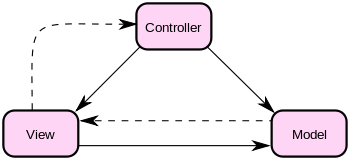Model-View-Controller (MVC2) and Model-View-Controller 2 (MVC2) are the de-facto patterns to use when developing Java and .NET web applications.
Here is a checklist to follow in order to apply the MVC pattern in Java:- Each of your JSP page (the View) has a corresponding servlet (the Controller).
- Your database objects are mapped to "Model Objects", usually POJOs that mirror the database structure to Java Objects. (the Model).
- From your web application pages, you have no direct html links to your JSP pages. Instead, your links point to the corresponding servlet of each JSP page.
- Each JSP page posts back to its Controller servlet. In other words, the <form&ht; tag on your JSP page has
the action attribute set to the Controller servlet url.
Example: <form method="POST" action="/myServlet"> - Each Controller Servlet handles/checks for "actions" and after processing, forwards or redirects
to the JSP View Page. Here are some standard Controller Servlet actions:
- "edit": where the Controller Servlet calls the Model which loads a record from a database based on same criteria, and then forwards to the JSP View page. The record is shown to the user available for editing.
- "save": where the Controller Servlet loads data from the Http Request to the correspondind Model Object, calls a save routine and then forwards to a JSP View page.
- "create": where the Controller Servlet calls the correspondind Model Object's create method, and then forwards to a JSP View page. This is where our uses can create new records.
- "delete": where the Controller Servlet calls the corresponding Model Object's delete method, and then forwards to a JSP View page. This is where our uses delete records.
